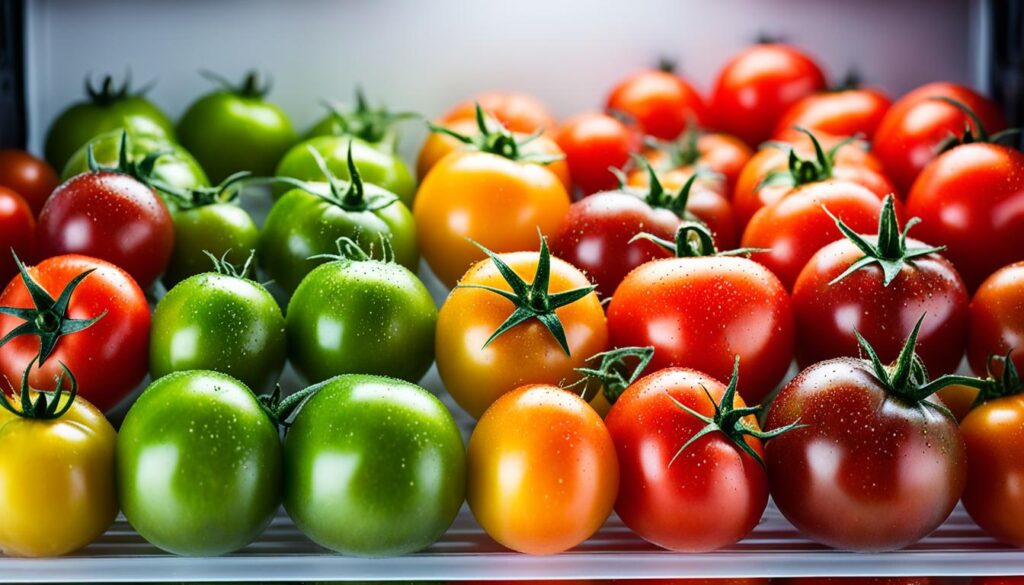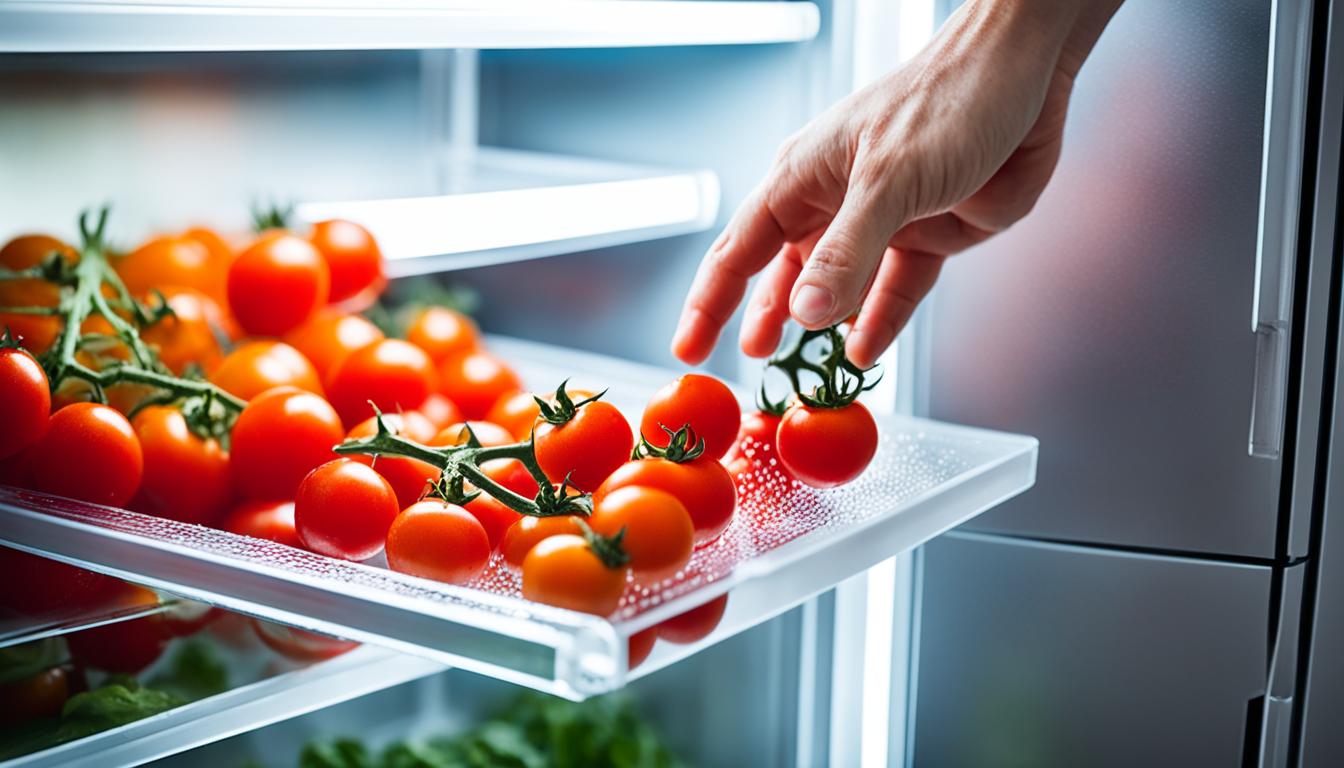Are you storing your tomatoes correctly? The shelf life and freshness of this vibrant fruit can greatly depend on how you store it. While it may seem counterintuitive, refrigeration can actually have several benefits when it comes to preserving tomatoes. But is it the right choice for all types of tomatoes? Let’s explore why you should consider refrigerating tomatoes and the advantages it offers.
Contrary to common belief, refrigerating tomatoes can extend their shelf life and help preserve their taste. While there is some controversy surrounding this topic, scientific experiments have shown that refrigeration can be beneficial for certain types of tomatoes. Unlike room temperatures that can vary widely, exposing tomatoes to high temperatures can lead to rapid rot and decomposition. Refrigerators, on the other hand, operate within a controlled temperature range, providing a more stable environment for your tomatoes to thrive.
It is recommended to remove the stems and store unripe tomatoes upside down at room temperature until they fully ripen. Once tomatoes are fully ripe, they can be refrigerated to buy some additional time before they begin to break down. However, it is important to allow refrigerated tomatoes to come to room temperature before serving to maximize flavor.
So, are you ready to unlock the full potential of your tomatoes by refrigerating them? Let’s dive deeper into the impact of refrigeration on tomato quality and explore the best practices for storing tomatoes.
The Impact of Refrigeration on Tomato Quality
Refrigeration can have a significant impact on the quality of tomatoes. When tomatoes are stored in the refrigerator, they undergo certain changes that can affect their texture and flavor. Refrigerated tomatoes may become slightly pulpy and less acidic, resulting in an alteration of their natural characteristics. However, it’s important to note that the negative effects of refrigeration are more pronounced in lower-quality and underripe tomatoes compared to ripe, delicious ones.
To ensure optimal flavor and freshness, it’s crucial to bring refrigerated tomatoes back to room temperature before serving. This allows the tomatoes to regain their natural taste and texture. When using refrigerated tomatoes, they work best in cooked dishes rather than consuming them raw. Cooking can help minimize the potential loss of flavor and texture that may occur due to refrigeration.
While refrigeration may alter the characteristics of tomatoes, it can still be a useful method for extending their shelf life and preserving their freshness. By understanding the impact of refrigeration on tomato quality, you can make informed decisions about how to store and use tomatoes to ensure the best possible culinary experience.
Best Practices for Storing Tomatoes
To ensure the freshness and flavor of your tomatoes, it’s important to store them correctly. Here are some tried and tested methods to keep your tomatoes at their best:
- Room Temperature Ripening: Allow tomatoes to ripen fully at room temperature. This allows them to develop their full flavor potential before refrigeration.
- Refrigeration for Shelf Life Extension: Once tomatoes are fully ripe, you can refrigerate them to extend their shelf life. This is especially useful if you have a surplus of ripe tomatoes and want to enjoy them over a longer period.
- Storing Large Tomato Varieties Stem Side Down: When storing larger tomato varieties, such as beefsteak tomatoes, it’s best to store them stem side down. This helps them stay fresher for longer and reduces moisture loss.
- Storing Cut Tomatoes: If you’ve cut a tomato and want to store the remaining portion, it’s recommended to store it in the refrigerator with the cut side down. Placing it in a container helps maintain its freshness and prevents it from drying out.
- Freezing Tomatoes: If you have an abundance of tomatoes and want to preserve them for future use, freezing is a great option. You can either briefly boil the tomatoes to loosen the skins and remove them before freezing, or slice them into 1/2 inch pieces and freeze them in airtight containers. Freezing tomatoes is an excellent way to enjoy their flavor even when they’re out of season.
By following these best practices, you can ensure that your tomatoes stay fresh and delicious for longer. Remember to bring refrigerated tomatoes back to room temperature before serving to maximize their flavor. Experiment with different storage methods and find what works best for you!
Exploring Different Perspectives on Refrigerating Tomatoes
When it comes to refrigerating tomatoes, there are varying opinions on whether it’s the right approach. Some experts argue against refrigeration, believing that it can lead to a loss of flavor and texture. They maintain that tomatoes are best served at room temperature, as cooler temperatures can hinder the full ripening of underripe tomatoes. However, other experts see benefits in refrigerating tomatoes, particularly in certain situations.
Refrigeration can help prevent spoilage in warm and humid kitchen environments, where tomatoes are more susceptible to rapid deterioration. Additionally, refrigerating overripe tomatoes can halt the ripening process, giving them some extra time before they begin to break down. This can be particularly useful if you have a surplus of ripe tomatoes and want to extend their shelf life.
While refrigeration can be a useful tool for preserving tomatoes, it’s important to note that the flavor of refrigerated tomatoes is optimized when they are brought back to room temperature before consuming. This allows the natural flavors to fully develop and enhances the taste experience. So, if you choose to refrigerate your tomatoes, be sure to allow them to come to room temperature for the best flavor.
Overall, the decision to refrigerate tomatoes or not ultimately depends on personal preference and specific circumstances. Whether you prefer the convenience of a longer shelf life or savor the taste of room-temperature tomatoes, both options can be valid. We recommend experimenting with different storage methods to find what works best for you.

Benefits of Refrigerating Tomatoes:
- Prevents spoilage in warm and humid environments
- Extends the shelf life of ripe tomatoes
- Halts the ripening process for overripe tomatoes
Considerations for Refrigerating Tomatoes:
- Bringing refrigerated tomatoes to room temperature for optimal flavor
- Personal preference plays a role in the decision
- Experiment with different storage methods to find what suits your taste
Embracing Personal Preferences in Tomato Storage
When it comes to storing tomatoes, there are guidelines and scientific experiments that provide insights into the best practices. However, personal preferences also play a significant role in the decision-making process.
Some people may prefer the taste and texture of room temperature tomatoes, savoring the natural sweetness and juiciness that comes with it. On the other hand, others may enjoy the cooling effect of refrigerated tomatoes, especially during hot summer months.
As long as the tomatoes are stored safely, it’s perfectly acceptable to deviate from the recommended storage methods. Experimenting and finding what works best for individual taste preferences can enhance the enjoyment of tomatoes in various culinary applications.
Ultimately, the decision of whether to store tomatoes in the fridge or at room temperature is a matter of personal preference. Whether you choose to cool them down or relish them at their natural state, satisfying your own taste buds is what matters most.
